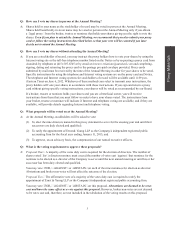Autodesk 2012 Annual Report Download - page 19
Download and view the complete annual report
Please find page 19 of the 2012 Autodesk annual report below. You can navigate through the pages in the report by either clicking on the pages listed below, or by using the keyword search tool below to find specific information within the annual report.
13
PROPOSAL THREE
NON-BINDING VOTE TO APPROVE NAMED EXECUTIVE COMPENSATION
The Dodd-Frank Wall Street Reform and Consumer Protection Act of 2010, or the Dodd-Frank Act, enables
our stockholders to vote to approve, on an advisory or non-binding basis, the compensation of our named
executive officers as disclosed in accordance with the SEC’s rules in the “Executive Compensation” section of
this proxy statement beginning on page 20 below. This proposal, commonly known as a “say-on-pay” proposal,
gives our stockholders the opportunity to express their views on our named executive officers’ compensation as
a whole. This vote is not intended to address any specific item of compensation or any specific named executive
officer, but rather the overall compensation of all of our named executive officers and the philosophy, policies
and practices described in this proxy statement.
The say-on-pay vote is advisory, and therefore not binding on the Company, the Compensation Committee
or our Board. The say-on-pay vote will, however, provide information to us regarding investor sentiment about
our executive compensation philosophy, policies and practices, which the Compensation Committee will
consider when determining executive compensation for the remainder of the current fiscal year and beyond.
Our Board and our Compensation Committee value the opinions of our stockholders and to the extent there
is any significant vote against the named executive officer compensation as disclosed in this proxy statement,
we intend to communicate directly with stockholders to better understand the concerns that influenced the
vote, consider our stockholders’ concerns and evaluate whether any actions are necessary to address those
concerns. As discussed below, after receiving the results of the say-on-pay vote from our 2011 Annual Meeting
of Stockholders, in which over 84% of the votes cast voted in favor of the compensation of our named executive
officers, we proactively engaged with our major stockholders to obtain their views and feedback on the
Company’s executive compensation programs.
Following is a summary of some of the key points of our 2012 executive compensation program. See the
“Executive Compensation” section beginning on page 20 below for more information.
Financial Performance in Fiscal 2012 and its Effect on Executive Compensation Paid for Fiscal 2012
We experienced an increase in demand for our products and services in all of the geographies and the
majority of the industries we serve during fiscal 2012 as compared to fiscal 2011. This positively impacted our
financial results and stock price for the first half of the year. In addition, we continued to make progress in
controlling our operating costs, which led to year over year improvements in our non-GAAP operating margin.
We believe that the improvements in these areas are indications of a broad-based stabilization of our business –
even though our stock price in the latter half the year was heavily burdened by uncertainty in the financial
markets resulting from domestic and European sovereign debt crises, among other things. The table below sets
forth the improvements in our revenue, non-GAAP income from operations and non-GAAP operating margin
from fiscal 2011 to fiscal 2012:*
Fiscal 2012 Fiscal 2011 Change
(in millions of dollars)
Revenue .................................... $2,215.6 $1,951.8 14%
Non-GAAP income from operations ............. $ 533.4 $ 418.8 27%
Non-GAAP operating margin . . . . . . . . . . . . . . . . . . 24% 21% 12%
Despite strong financial performance, our stock price was extremely volatile during fiscal 2012. Our total
stockholder return during fiscal 2012 declined 15%, with our stock price depreciating from $42.16 on the first
trading day of fiscal 2012 to $36.00 on the last trading day of fiscal 2012, with the stock price reaching a high of
$45.99 and a low of $23.41 during that period. Our total stockholder return from January 31, 2010 to January 31,
2012 was approximately 51%.
* A reconciliation of GAAP to non-GAAP results is available in Appendix A.
Proxy Materials
























